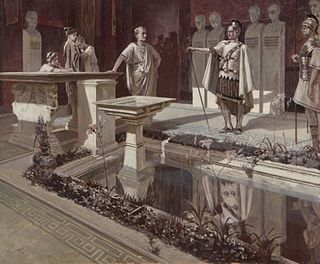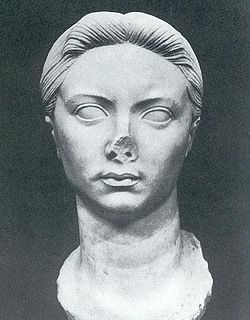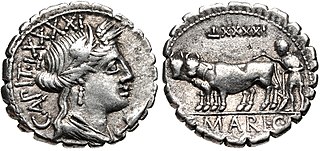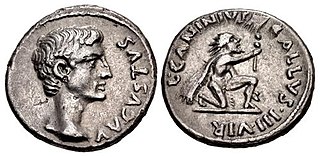Related Research Articles
The 20s decade ran from January 1, AD 20, to December 31, AD 29.

The gens Petronia was a plebeian family at ancient Rome. This gens claimed an ancient lineage, as a Petronius Sabinus is mentioned in the time of Lucius Tarquinius Superbus, the last of the Roman kings, but few Petronii are mentioned in the time of the Republic. They are frequently encountered under the Empire, holding numerous consulships, and eventually obtaining the Empire itself during the brief reign of Petronius Maximus in AD 455.

Aulus Plautius was a Roman politician and general of the mid-1st century. He began the Roman conquest of Britain in 43, and became the first governor of the new province, serving from 43 to 46 CE.

Vipsania Agrippina was the first wife of the Emperor Tiberius. She was the daughter of Marcus Vipsanius Agrippa and Pomponia Caecilia Attica, thus a granddaughter of Titus Pomponius Atticus, the best friend of Cicero.
GaiusPomponius Graecinus was a Roman politician who was suffect consul in AD 16 as the colleague of Gaius Vibius Rufus. He was probably a novus homo raised to the Senate by Augustus. He was a friend and patron of the poet Ovid, who addressed three letters of his Epistulae ex Ponto to him around AD 10.
Appius Junius Silanus, whom Cassius Dio calls Gaius Appius Silanus, was consul in AD 28, with Publius Silius Nerva as his colleague. He was accused of majestas, or treason, in AD 32 along with a number of senators, but he and Gaius Calvisius Sabinus were saved by one of the informers, Celsus, a tribune of a city cohort.
Publius Cornelius Lentulus Scipio was a Roman senator active during the Principate. He was suffect consul in the nundinium of July-December AD 24, as the colleague of Gaius Calpurnius Aviola. His name combines the two most famous branches of the gens Cornelia, the Lentuli and the Scipiones.
Licinia is the name used by ancient Roman women of the gens Licinia.
Gaius Vibius Marsus, whom Tacitus calls "vetustis honoribus studiisque illustris", was a Roman senator active during the Principate. He was consul in 17 AD.

The gens Maria was a plebeian family of Rome. Its most celebrated member was Gaius Marius, one of the greatest generals of antiquity, and seven times consul.

The gens Caninia was a plebeian family at ancient Rome during the later Republic. The first member of the gens who obtained any of the curule offices was Gaius Caninius Rebilus, praetor in 171 BC; but the first Caninius who was consul was his namesake, Gaius Caninius Rebilus, in 45 BC.
Publius Petronius was a Roman senator, who was active during the reigns of Caligula and Claudius. He was suffect consul in the second half of the year 19, replacing Lucius Norbanus Balbus. The sortition also awarded him the proconsulate of Asia; however, Petronius is best known as having appointed legatus or governor of Syria in 39, probably arriving in the country late in the year. A.A. Barrett lists him as an example of the "excellent appointments" made by an emperor often dismissed as mentally unbalanced.
Marcus Herennius Picens was a Roman senator who served as suffect consul in 34 BC, replacing Gaius Memmius and occupying the office from November 1 to the end of December.
Gaius Catius Clemens was a Roman military officer and senator who was appointed suffect consul around AD 235.
Lucius Catius Celer was a Roman military officer and senator who was appointed suffect consul around AD 241.
Publius Cornelius Dolabella was a Roman senator who was appointed suffect consul in 35 BC with Titus Peducaeus as his colleague.
The Testamentum Dasumii refers to an inscription in several pieces found in Rome, that bears the only Roman will inscribed on stone. Originally presenting the complete will, while the surviving pieces of the inscription include parts of all 133 lines, much of the beginning and ends of all of the lines are missing. Nevertheless, it is of great value for prosopographic reasons, as well as an example of a Roman legal document for which otherwise there are few examples.
Quintus Plautius was a Roman senator, who was active during the Principate.
References
- ↑ Alison E. Cooley, The Cambridge Manual of Latin Epigraphy (Cambridge: University Press, 2012), p. 459
- ↑ CIL VI, 1266; Borghesi, Œuvres complètes de Bartolomeo Borghesi (1860), III p. 343
- ↑ Rudolf Hanslik, "Petronius 22", Realencyclopädie der classischen Altertumswissenschaft (Stuttgart, 1937) Vol. 19,1, Col. 1199